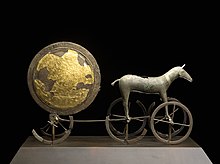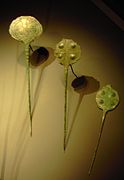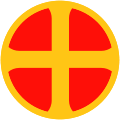| This article needs additional citations for verification. Please help improve this article by adding citations to reliable sources. Unsourced material may be challenged and removed. Find sources: "Sun cross" – news · newspapers · books · scholar · JSTOR (August 2019) (Learn how and when to remove this message) |

A sun cross, solar cross, or wheel cross is a solar symbol consisting of an equilateral cross inside a circle.
The design is frequently found in the symbolism of prehistoric cultures, particularly during the Neolithic to Bronze Age periods of European prehistory. The symbol's ubiquity and apparent importance in prehistoric religion have given rise to its interpretation as a solar symbol, whence the modern English term "sun cross" (a calque of German: Sonnenkreuz). The symbol means village in Ancient Egyptian (Gardiner symbol O49).
The same symbol is in use as a modern astronomical symbol representing the Earth rather than the Sun. In pharmacy, sun cross symbol represents various/miscellaneous drugs.
After World War II, variants of the symbol became associated with neo-Nazi and white supremacist movements.
Interpretation as solar symbol

The interpretation of the simple equilateral cross as a solar symbol in Bronze Age religion was widespread in 19th-century scholarship. The cross-in-a-circle was interpreted as a solar symbol derived from the interpretation of the disc of the Sun as the wheel of the chariot of the Sun god. Wieseler (1881) postulated an (unattested) Gothic rune hvel ("wheel") representing the solar deity by the "wheel" symbol of a cross-in-a-circle, reflected by the Gothic letter hwair (𐍈).
The English term "Sun-Cross", on the other hand, is comparatively recent, apparently loaned from German Sonnenkreuz and used in the 1955 translation of Rudolf Koch's Book of Signs ("The Sun-Cross or Cross of Wotan", p. 94).
The German term Sonnenkreuz was used in 19th-century scholarly literature of any cross symbol interpreted as a solar symbol, an equilateral cross either with or without a circle, or an oblique cross (saltire). Sonnenkreuz was used of the flag design of the Paneuropean Union in the 1920s. In the 1930s, a version of the symbol with broken arms (resembling a curved swastika, illustrated below) was popular as a link between Christianity and Germanic paganism in the völkisch German Faith Movement.
Archaeological record
Bronze Age
In the prehistoric religion of Bronze Age Europe, crosses in circles appear frequently on artifacts identified as cult items, for example the "miniature standard" with an amber inlay that shows a cross shape when held against the light, dating to the Nordic Bronze Age, held at the National Museum of Denmark, Copenhagen. The Bronze Age symbol has also been connected with the four-spoked chariot wheel, which is attested in Bronze Age Scandinavia, Central Europe and Greece (compare the Linear B ideogram 243 "wheel" 𐃏). In the context of a culture that celebrated the sun chariot, it may thus have had a "solar" connotation (compare the Trundholm sun chariot).
-
 Ornamental pins, found in Switzerland, date to the first half of the 2nd millennium BC; their circular heads are incised with crosses
Ornamental pins, found in Switzerland, date to the first half of the 2nd millennium BC; their circular heads are incised with crosses
-
 Wheel pendants dating to the second half of the 2nd millennium BC, found in Zürich. Variants include a six-spoked wheel, a central empty circle, and a second circle with twelve spokes surrounding one of four spokes.
Wheel pendants dating to the second half of the 2nd millennium BC, found in Zürich. Variants include a six-spoked wheel, a central empty circle, and a second circle with twelve spokes surrounding one of four spokes.
-
 A sun disk found in tombs in Alacahöyük dates back to the early Bronze Age. Notice the three sun crosses on the sun disk.
A sun disk found in tombs in Alacahöyük dates back to the early Bronze Age. Notice the three sun crosses on the sun disk.
-
 Amber sun cross, Nordic Bronze Age, Denmark.
Amber sun cross, Nordic Bronze Age, Denmark.
-
 Corded Ware culture amber sun disc (illustration)
Corded Ware culture amber sun disc (illustration)
Modern culture
Astronomy
The same symbol represents the Earth in astronomical symbols, while the Sun is represented by a circle with a center point.
Commerce
The Atchison, Topeka, and Santa Fe Railroad emblem was a cross in a circle with the words "Santa Fe" across the horizontal bar. In this case, the lines making up the cross were much wider than the circle.
Ethnography
The Sacred Hoop aka Medicine Wheel is a similar symbol in widespread use by Native Americans including Plains Indians and previously by Hopewell cultures. Other indigenous peoples also use or used the solar cross on their symbolism and as decoration practices.
Politics
The Sassanian Empire in Persia used a similar solar cross on their banner, called the Derafsh Kaviani symbol.
The Norwegian fascist party Nasjonal Samling used a golden sun cross on a red background as an official symbol from 1933 to 1945. The cross with the circle was associated with Olaf II of Norway, patron saint of Norway, and the colors were the coat of arms of Norway.
The Paneuropean Union, a European unification movement, uses this symbol as central element of its flag.
A square cross interlocking with or surrounded by a circle is one of the most popular symbols used by individuals and organisations to represent white nationalism, white supremacy, Neo-Nazism, and white pride. In its Celtic cross form, it is used as the logo for white nationalist website Stormfront. This stems from the use of a circled cross by Norwegian Nazis during World War II. In New Zealand, the Odin's cross was one of the symbols used by on Brenton Tarrant in the Christchurch mosque shootings.
In Germany, a "stylized" circled cross was adopted by a prohibited political party (VSBD/PdA), leading to a ban of the symbol if used within a context of promoting racism (see Strafgesetzbuch section 86a). Although there were doubts on the constitutionality of the ban, it was upheld in a decision of the supreme court.
In Italy, there is a similar ban based on Legge Mancino (the "Mancino Law", from the Minister of Interior who enacted the law), although there are some examples of the use of the circled cross as a Roman Catholic symbol in Northern Italy.
Tools
A similar glyph is used in tool sets to denote Phillips-head screws and screwdrivers.
Unicode
There is no formal code point in Unicode for this symbol, though other symbols representing the sun are included. Symbols designed for other purposes, such as U+1F728 🜨 ALCHEMICAL SYMBOL FOR VERDIGRIS, U+2295 ⊕ CIRCLED PLUS and U+2A01 ⨁ N-ARY CIRCLED PLUS OPERATOR, and U+2316 ⌖ POSITION INDICATOR are similar.
Examples
-
 Sun wheel
Sun wheel
-
 Earth astronomical symbol
Earth astronomical symbol
-
 Broken sun cross or "circle swastika" (cf. swastika)
Broken sun cross or "circle swastika" (cf. swastika)
-
 Caddo sun cross
Caddo sun cross
-
 Ashur sun cross
Ashur sun cross
-
 Sun cross of Ashur and crescent moon of Nanna
Sun cross of Ashur and crescent moon of Nanna
-
 Shimazu clan mon
Shimazu clan mon
-
 Former flag of Daejeon, South Korea (1972–1995) contains small green sun cross in the centre
Former flag of Daejeon, South Korea (1972–1995) contains small green sun cross in the centre
-
 Emblem of Nasjonal Samling
Emblem of Nasjonal Samling
-
 Flag of Hirden
Flag of Hirden
-
 Emblem of the Atchison, Topeka, and Santa Fe Railway
Emblem of the Atchison, Topeka, and Santa Fe Railway
-
 The Celtic wheel cross is not a sun symbol though superficially similar
The Celtic wheel cross is not a sun symbol though superficially similar
See also
- Circled plus (disambiguation) (⊕)
- Astrological symbols – Symbols denoting astrological concepts
- Black Sun (symbol) – Neo-Nazi and esoteric symbol
- Celtic cross – Christian cross superimposed on a circle
- Coptic cross – Cross associated with Coptic Christians
- Cross – Geometrical figure
- Direct sum – Operation in abstract algebra composing objects into "more complicated" objects
- Earth symbol – Astronomical symbols for the planet Earth, alchemical symbol for the element Earth
- Exclusive or – True when either but not both inputs are true
- Ringed cross – Cross enclosed in a ring or halo
- Solar symbol – Symbol representing the Sun
- Swastika – Ancient Eurasian icon and later Nazi symbol
- Tursaansydän – Ancient symbol used in Northern Europe
- Western use of the swastika in the early 20th century – Use of ancient religious symbol
References
- ^ "Political Symbols". politicalsymbols.net.
- Martin Persson Nilsson (1950). The Minoan–Mycenaean Religion and its Survival in Greek Religion. Biblo & Tannen Publishers. p. 421.
there is a wide-spread opinion that the equal-limbed cross is another symbol of the sun. It was, for example, a favorite theory of the late Professor Montelius, and has been embraced by many other archaeologists; its wide acceptance is due to an interest in finding a pre-Christian origin of the symbol of Christianity. The disc of the sun was regarded as a wheel; hence the myth that the sun-god drives in a chariot across the heavens.
- Karl Georg Wieseler (1813–83), Untersuchungen Zur Geschichte Und Religion Der Alten Germanen in Asien und Europa, 1881, p. 157. The suggestion of a specifically Gothic variant of the runic alphabet partially preserved in the Gothic alphabet is due to Jacob Grimm's Deutsche Mythologie (1835).
- Richard Nicolaus Graf von Coudenhove-Kalergi, Kampf um Paneuropa aus dem 1. Jahrgang von Paneuropa, Paneuropa Verlag, 1925, p. 36.
- For example:
- Karl Hans Strobl, Die Runen und das Marterholz, Zwinger-Verlag, 1936, p. 138
- Waldemar Müller-Eberhart, Kopf und herz des Weltkrieges: General Ludendorffs Wertung als Deutscher, Georg Kummer, 1935, p. 244.
- entry at the Nebra sky disk exhibition site (landesmuseum-fuer-vorgeschichte-halle.de)
- Meller, Harald (2021). "The Nebra Sky Disc – astronomy and time determination as a source of power". Time is power. Who makes time?: 13th Archaeological Conference of Central Germany. Landesmuseum für Vorgeschichte Halle (Saale). ISBN 978-3-948618-22-3. Archived from the original on 9 January 2023. Retrieved 10 January 2023.
- "BGH, Beschluss vom 01.10.2008 - 3 StR 164/08". Retrieved 27 March 2020.
- "Criminal Code (1993) (excerpts)". LegislatiOnline.
